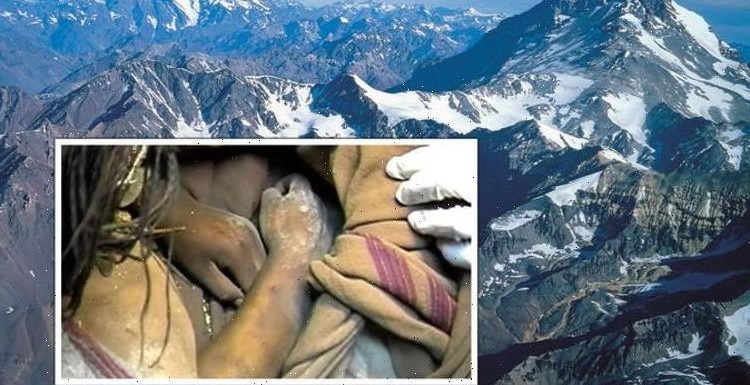
Beyond Oak Island: Gary recalls Inca civilization gold discovery
We use your sign-up to provide content in ways you’ve consented to and to improve our understanding of you. This may include adverts from us and 3rd parties based on our understanding. You can unsubscribe at any time. More info
The discovery was heralded as one of the finest and “perfect” of its kind. Researchers climbed 22,000 feet up into Argentina’s portion of the Andean mountains onto the world’s tallest active volcano before stumbling across the remains. What they found was astonishing: a female teenager, around 13 years old, wrapped in a blanket pressed tightly around her crouched body, along with another girl and boy believed to be four or five years old.
Taken away for analysis, the remains were found to be 500 years old, placing their identities as Inca, the great empire which dominated South America until Europeans arrived at the end of the 15th century.
Despite being buried under about 1.5 metres (5ft) of rock and earth, their internal organs look perfect on a CT scan — as if they had died only recently.
Dr Johan Reinhard, an archaeologist who helped lead the team, at the time said the remains were, “the best preserved of any mummy I’ve seen”.
He recounted his momentous 1999 excavation during the Smithsonian Channel’s documentary, ‘Mummies Alive: The Inca Maiden’, 16 years later.
Reaching the peak of Mount Llullaillaco, he said: “All of a sudden I heard this guy cry out, ‘Mummy!’.


“When she first came out of the ground, she was completely wrapped up.
“We couldn’t see any part of her body, but the textiles were just outstanding, and they were so well preserved.”
The biggest surprise came when they removed her wrappings.
As Dr Reinhard gently worked his way down from the top, a full head of hair appeared.
He said: “We had to talk while we were doing it — it was if we were afraid at some level we might wake this mummy up because she seemed so alive.
“But nothing had the impact of when we uncovered her hands — it was probably one of the most powerful experiences I’ve had in my life, because those hands were perfect.”
JUST IN: US deal struck to restart CO2 production as EU chiefs hold meeting

The maiden’s hands — as she was later called by researchers involved with the work — had all the details of a living hand, their skin, creases and nails were all intact.
Preserved along with her was a spectacular collection of artefacts, including ceramics, figurines and textiles.
Everything appeared “totally untouched”, not a colour had faded in any of the materials, nor had any of the relics been damaged or changed in any way since they had been buried hundreds of years ago.
Since the initial discovery, extensive research had seen the maiden’s story take a sinister turn.
In 2013, scientists revealed that drugs and alcohol played a key part in the months and weeks leading up to the children’s deaths.
Tests on one of the children, a teenage girl, suggest that she was heavily sedated just before her demise.
Dr Emma Brown, from the department of archaeological sciences at the University of Bradford, said: “The Spanish chroniclers suggest that children were sacrificed for all kinds of reasons: important life milestones in the lives of the Incas, in times of war or natural disasters, but there was a calendar of rituals too.”
DON’T MISS
Archaeology breakthrough after researchers found new human species’ [REPORT]
Bermuda Triangle probe boost after 80-year-old shipwreck discovery [INSIGHT]
Bermuda Triangle investigators find ‘best evidence we’ve seen’ [ANALYSIS]


The international team of researchers used forensic tests to analyse the chemicals found in the children’s hair.
They discovered that all three had consumed alcohol and coca leaves (from which cocaine is extracted) in the final months of their lives.
Historical records reveal that these substances were reserved for the elite and often used in Incan rituals.
An analysis of the teenage girl’s hair – which was considerably longer than the hair of the other victims — revealed further details.
She was likely considered more valued than the younger children because of her virginal status.
Tests on her long braids revealed that her coca consumption increased sharply a year before her death.

The scientists believe this corresponds to the time she was selected for sacrifice.
Earlier research also revealed that her diet changed around this point too — from a potato-based peasant diet to one rich in meat and maize.
Dr Brown told the BBC: “From what we know of the Spanish chronicles, particularly attractive or gifted women were chosen.
“The Incas actually had someone who went out to find these young women and they were taken from their families.”

The results also revealed that the girl ingested large amounts of alcohol in the last few weeks of her life.
It suggests she was heavily sedated before she and the other children were taken to the volcano, placed in their tombs and left to die.
In the case of the maiden, there was no sign of violence.
Dr Brown added: “In this case we think with the combination of being placed in the grave with the alcohol and the cold ‒ the mountain is over 6,000m above sea level ‒ she would have passed away quietly.”
Source: Read Full Article